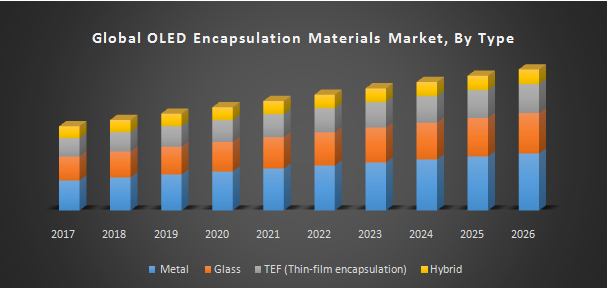Global OLED Encapsulation Materials Market – Industry Analysis and ForecastPosted by Shubhangi Sapkal on August 20th, 2019 Global OLED Encapsulation Materials Market was valued US$ XX Bn in 2017 and is expected to reach US$ XX Bn by 2026 at a CAGR of XX% during the forecast period.
Surge in smartphone demand, increase in disposable income of consumers, and increase in the use of these materials in the automotive industry are expected to propel the growth of the global OLED materials market. With the development in technology, the quality of displays has also improved. This has increased the demand for OLED displays in smartphones, which has, in turn, boosted the growth of the OLED materials market. Consumers now prefer to use smartphones having a high-quality display which can be provided with OLED films. With the rise in disposable income, people are now moving toward high-quality products. Customers prefer electronic goods which come with all the features like internet, camera, and other multimedia, and are ready to pay for them. For More Information About Report Visit: https://www.maximizemarketresearch.com/market-report/global-oled-encapsulation-materials-market/30493/ This has lacking the manufacturers to manufacture OLED display smartphones, resulting in the growth of the market. The OLED materials market has seen significant growth in recent times. However, the material has certain drawbacks too. For instance, the lifetime of conventional OLED displays is around 5,000 hours, while that of normal LCD displays is around 10,000 hours. Also, the material is easily damaged by water, due to which an improved sealing process is necessary for the displays; thus, the above-mentioned factors are restraining the growth of the market. The metal type is estimated to lead the market in terms of revenue because it is mainly used for OLED TVs whose growth is fastest. Also, with Chinese smartphone brands releasing a wide range of new products with OLED panels, demand for frit glass encapsulation materials, which are currently applied to smartphones with rigid-OLED displays, will remain steady, though losing its market share. In terms of revenue, metal type encapsulation is expected to account for 50 per cent and the frit glass type to take 43 per cent in 2017, and 67 per cent and 23 per cent in 2021, respectively. Hybrid encapsulation, which combines TFE with a barrier film, has high production cost and its flexibility is limited, and thus demand for the hybrid type will not increase significantly, However, the latecomers are focusing on the hybrid encapsulation as it has a lower technological entry barrier compared to TFE, allowing them to succeed in mass production faster than when using TFE. In terms of end user, the OLED materials market is segmented into residential, commercial, and industrial sectors. Residential has been the largest category in the market, with more than 45.0% share in 2017. This can be attributed to the increasing use of these materials due to growth in residential projects and rise in disposable income. Globally, Asia-Pacific has been the leading OLED materials market in terms of size. Most of the companies in the region are now adopting the use of OLED technology attributed to the fact that consumers want to experience high definition displays. Additionally, rise in offline sales channels and aggressive advertising campaigns by the key players in the smartphone industry are expected to augment its demand further in the region. Also, car manufacturers are preferring advanced headlight display, heads up display unit, and ambient lighting which uses this material, thus resulting in the growth of the market. The objective of the report is to present a comprehensive assessment of the market and contains thoughtful insights, facts, historical data, industry-validated market data and projections with a suitable set of assumptions and methodology. The report also helps in understanding dynamics, structure by analyzing the market segments by type, service, components, and region and, project the global market size. The report also provides a clear representation of competitive analysis of key players by product, price, financial position, product portfolio, growth strategies, and regional presence in the OLED Encapsulation Materials market. The report also provides PEST analysis, PORTER’s analysis, SWOT analysis to address the question of shareholders in arranging the efforts and investment in the near future to a particular market segment. Scope of Global OLED Encapsulation Materials MarketGlobal OLED Encapsulation Materials Market, By Type• Metal • Glass • TEF (Thin-film encapsulation) • Hybrid Global OLED Encapsulation Materials Market, By End User• Residential • Commercial • Industrial Global OLED Encapsulation Materials Market, By Region• North America • Europe • Asia Pacific • Middle East & Africa • South America Key players operating in Global OLED Encapsulation Materials Market• Samsung Display • LG Display Co., Ltd. • AU Optronics Corp. • Shenzhen Star Optoelectronic Technology Co. Ltd. • Visionox Company • Sony Corporation of America • Panasonic Corporation • Japan Display Inc. • Foxconn Electronics Inc. • Toshiba Corporation.
Like it? Share it!More by this author |



